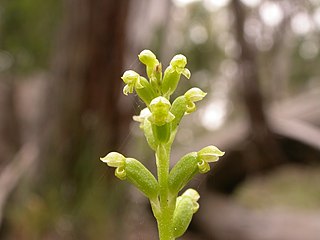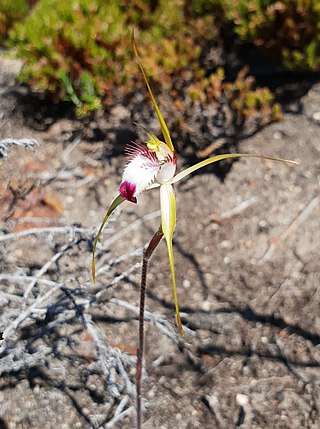
Cyrtostylis huegelii, commonly known as the western common gnat orchid or midge orchid, is a species of orchid endemic to Western Australia. It usually has a single rounded leaf and a flowering spike with up to fifteen pale green and dull red flowers with a purplish, shelf-like labellum. Some authorities regard C. huegelii as a synonym of Cyrtostylis reniformis var. huegelii.

Microtis parviflora, commonly known as the slender onion-orchid, is a species of orchid which is native to Australia and New Zealand. It occurs in all states of Australia but is not known from the Northern Territory and may not occur in Western Australia. As with others in the genus, it has a single erect, smooth, tubular leaf and up to eighty flowers on an erect flower spike.

Caladenia graniticola, commonly known as the Pingaring spider orchid, is a species of orchid endemic to the south-west of Western Australia. It has a single, hairy leaf and one or two yellowish-green, red and white flowers which have a greenish-yellow and white labellum with a red tip. It was originally described as Caladenia hoffmanii subsp. graniticola but has a slightly different labellum and column.
Caladenia hoffmanii, commonly known as Hoffman's spider orchid, is a species of orchid endemic to the south-west of Western Australia. It has a single, hairy leaf and one or two, greenish-yellow, red and white flowers which have a greenish-yellow labellum with a red tip. It is distinguished from the Pingaring spider orchid by small differences in the labellum and more northerly distribution.
Caladenia remota subsp. remota, commonly known as the outback spider orchid, is a plant in the orchid family Orchidaceae and is endemic to the south-west of Western Australia. It has a single hairy leaf and one or two relatively large creamy-white to pale yellow flowers. It is relatively common in moist soil around granite outcrops, growing in more inland areas than most other spider orchids.
Pterostylis macrosceles, commonly known as the slender rufous greenhood is a plant in the orchid family Orchidaceae and is endemic to the south-west of Western Australia. Both flowering and non-flowering plants have a relatively large rosette of leaves. Flowering plants also have between four and eight white flowers with green brown lines and small, insect-like labellum. It is distinguished from other Western Australian greenhoods by the unusually long thread-like tips on its sepals.
Pterostylis picta, commonly known as the painted rufous greenhood or painted rustyhood is a plant in the orchid family Orchidaceae and is endemic to the south-west of Western Australia. Both flowering and non-flowering plants have a relatively large rosette of leaves. Flowering plants also have up to seven large translucent white flowers with green and brown stripes and markings and a fleshy, insect-like labellum.

Pterostylis roensis, commonly known as the painted rufous greenhood or dark rustyhood is a plant in the orchid family Orchidaceae and is endemic to the south-west of Western Australia. Both flowering and non-flowering plants have a relatively large rosette of leaves. Flowering plants also have up to six green or brown to blackish flowers with translucent white panels and a dark brown, fleshy, insect-like labellum.

Microtis media subsp. media, commonly known as the common mignonette orchid, is a species of orchid which is endemic to the south–west of Western Australia. It is a common, widespread orchid with a single smooth, tubular leaf and a flowering spike with up to one hundred small green flowers. It differs from Microtis media subsp. densiflora in the shape of its flower spike and the shape of its labellum.
Microtis alba, commonly known as the white mignonette orchid or slender onion-orchid, is a species of orchid endemic to the south-west of Western Australia. It has a single hollow, onion-like leaf and up to sixty small, green and white flowers with a strong musky fragrance. It is much more common after a fire the previous summer than in unburned country.
Microtis atrata, commonly known as the swamp mignonette orchid or yellow onion orchid and sometimes as Microtidium atratum, is a species of orchid endemic to southern Australia. It has a single thin leaf and up to forty or more yellowish-green flowers. The flowers are the smallest of any Australian ground-dwelling orchid. The orchid usually grows in large colonies after fire and although small, are easily seen because of their very large numbers in their blackened surroundings.
Microtis brownii, commonly known as the sweet mignonette orchid or sweet onion orchid, is a species of orchid endemic to the south-west of Western Australia. It has a single hollow, onion-like leaf and up to sixty small, green and white scented flowers well-spaced along the flowering stem. It usually grows in swampy places, flowers more prolifically after summer fires and sometimes forms very large colonies.

Microtis cupularis, commonly known as the cupped mignonette orchid sometimes as Hydrorchis cupularis, is a species of orchid endemic to the south-west of Western Australia. It has a single thin, hollow, onion-like leaf and up to thirty small, yellowish-green and red flowers. The plants often grow in shallow water and are self-pollinating.
Microtis media subsp. densiflora, commonly known as the dense mignonette orchid, is a species of orchid which is endemic to the south–west of Western Australia. It has a single smooth, tubular leaf and a flowering spike with up to one hundred and fifty small yellowish-green flowers. It differs from Microtis media subsp. media in the shape of its flower spike and the shape of its labellum.
Microtis quadrata, commonly known as the south coast mignonette orchid or south coast onion orchid, is a species of orchid endemic to south-west coastal areas of Western Australia. It has a single thin, hollow, onion-like leaf and up to one hundred small, pale green flowers. This onion orchid grows on low mounds in swamps, often with other species of mignonette orchids, and flowers much more prolifically after fire.

Microtis eremaea, commonly known as the slender mignonette orchid or inland onion orchid is a species of orchid endemic to the south-west of continental Australia. It has a single thin, hollow, onion-like leaf and up to fifty small greenish-yellow flowers. The flowers have a distinctive heart-shaped labellum and the orchid generally grows in more inland areas than most other onion orchids.
Microtis eremicola, commonly known as the desert mignonette orchid or dryland onion orchid, is a species of orchid endemic to the south-west of Western Australia. It has a single hollow, onion-like leaf and up to fifty small, dull green to greenish-yellow flowers. This onion orchid is common in soil pockets on granite outcrops in inland areas, mostly between Hyden and Balladonia.
Microtis familiaris, commonly known as the coastal mignonette orchid or coastal onion orchid is a species of orchid endemic to the south-west coastal region of Western Australia. It has a single hollow, onion-like leaf and up to twenty small, green to greenish-yellow, sweetly scented, widely spaced flowers. It often grows with large populations of other Microtis orchids but only flowers after fire.

Microtis orbicularis, commonly known as the dark mignonette orchid, is a species of orchid endemic to southern Australia. It has a single thin, more or less hollow, onion-like leaf and up to fifty small yellowish-green and red flowers. The plants grow in winter-wet areas, often in shallow water and unlike the similar M. cupularis do not turn black as they dry.
Pterostylis orbiculata, commonly known as the coastal banded greenhood, is a plant in the orchid family Orchidaceae and is endemic to the south-west of Western Australia. The plants either have a rosette of leaves in the years when not flowering or stem leaves on a flowering spike. When flowering, it has up to twenty flowers that are reddish brown, greenish brown or green with a reddish or brownish labellum with short stiff hairs.








